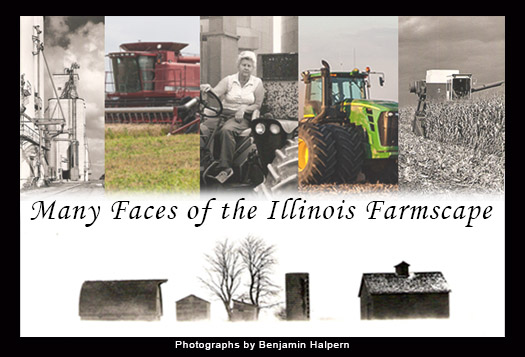
Many Faces of the Illinois Farmscape
Many people have farmed the Illinois Grand Prairie over the centuries. Indians burned the grasses to maintain hunting grounds. Stock-farmers grazed livestock on the tall grasses. After the Civil War, drainage made the wet prairie soils more suitable to row cropping. Over the next 100 years (1870s to 1970s) farm life changed drastically as corn transitioned from being something that hogs ate to being something that businesses processed, and as cropland became too expensive to dedicate to pasture. By the farm crisis of the early 1980s, the Grand Prairie -- from Charleston to Kankakee, and from Danville to Decatur -- included some of the most capital-intensive row-crop farms in the nation, but the number of farm families dropped precipitously. This database share their stories with you.
The modern landscape bears little resemblance to the landscape that today’s eldest farmers first cultivated. The 80- and 90-year-olds lived through major transitions (from horse to tractor power, from organic fertilizers to synthetic nitrogen-phosphorous-potassium applications, from plows to no-till, and from integrated pest management to synthetic pesticide treatments). How does personal memory (the living memory that individuals hold and that families sustain) inform these modern operations? The knowledge of the long-term rhythms of the seasons -- cold, snow, heat, drought, spring rains and flood -- affect farm family decisions. Different philosophies of land and farm stewardship, learned over years of adjusting to market forces and farm policy and local crop and stock cultures, inform their decisions.
As a consequence, farm families on the Grand Prairie adopt a variety of approaches to remain in business and meet market demand. A close look at the modern agricultural landscape -- the farmscape -- indicates that farmers take debates about GMOs and organic farming seriously. Thus, the perception of monoculture differs from the reality on the ground -- from large-scale arable crop cultivation to organic market gardening and from confinement livestock operations to free-range pasture. Farm families respond to them by practicing a wide-range of organic agriculture in the heart of the Corn Belt.
Farmers adopt business plans to manage risk and negotiate legal contracts to keep their operations viable. This necessitates a mutual dependency between farm families and farm businesses. Agricultural equipment dealerships, co-operatives, grain-elevator operators, bankers, Farm Bureau technical experts, and feed-mill businesses all cohabitate in the Grand Prairie, and each needs the other. This database provides access to their stories. Density indicates the viability of the farmscape: Are there enough co-ops and grain elevators in business to meet the needs of the farmers in the radius navigable by eighteen-wheelers? Are there enough feed mills, livestock auction houses, or local butchers to meet the needs of farmers, be they anti-biotic free poultry or beef farmers, seed-stock producers, or free-range pig farmers? Are there enough farms raising seed to meet the demand for hybrid seed, or open-pollenated seeds, or other heritage varieties that warrant preservation? Are there enough farms raising breeding stock – the boars, bulls, rams, tom turkeys, roosters, and other livestock needed to maintain genetic diversity?
The oral histories and photographs available through this website document personal memories of and current approaches to farming Illinois. Documenting both the farm operators and the network of businesses that they depend on provides evidence of relationships made increasingly fragile as numbers of farmers decline and businesses struggle with maintaining adequate market density. This study documents the personal stories of the farm operators as well as the business operators. No other study had done that for a region of Illinois’ agricultural production.
The oral histories and photographs document farm families and farm businesses that survived the farm crisis of the late-1970s and early 1980s. This agri-ecosystem is remarkably fragile, propped up by government policy but riddled with anti-regulation and anti-government rhetoric. Understanding can come only from sitting down and listening to those who have managed their businesses between the late 1970s to the 2010s. The memoirs document many perspectives of those involved in farming, with particular attentive paid to how farm families and farm businesses managed conflict and managed to survive.
The resources in this database can help you learn about farmers and farm businesses today. It includes interviews with and photographs of farm families who remain in the fields, and farm business operators who serve those families. All do business in the Illinois Grand Prairie. This area includes eight counties in East Central Illinois including Champaign, Coles, Douglas, Ford, Iroquois, Piatt, Livingston, and Vermilion.
Browse the Many Faces of the Illinois Farmscape Collections:
Biographies of the "Many Faces" Investigators
- Farm Pictures (1980s)
- Farm Pictures (2010s)
- Oral History Interviews & Transcripts
- Project Permission Forms
- Farm Pictures (1980s)
- Farm Pictures (2010s)
- Oral History Interviews & Transcripts
- Project Permission Forms
- Farley Ear Corn Festival Harvest
- Farm Pictures (1980s)
- Farm Pictures (2010s)
- Oral History Interviews & Transcripts
- Project Permission Forms
- Farm Pictures (1980s)
- Farm Pictures (2010s)
- Oat Harvest and Straw Baling
- Oral History Interviews & Transcripts
- Project Permission Forms
- Farm Pictures (1980s)
- Farm Pictures (2010s)
- Oral History Interviews & Transcripts
- Project Permission Forms
- Farm Pictures (1980s)
- Farm Pictures (2010s)
- Oral History Interviews & Transcripts
- Project Permission Forms
- Farm Pictures (1980s)
- Farm Pictures (2010s)
- Oral History Interviews & Transcripts
- Project Permission Forms
- Farm Pictures (1980s)
- Farm Pictures (2010s)
- Oral History Interviews & Transcripts
- Project Permission Forms




